

A National Journal of Literature & Discussion

Hew Locke’s Wine Dark Sea
A #vqrtruestory essay, by gaiutra bahadur.
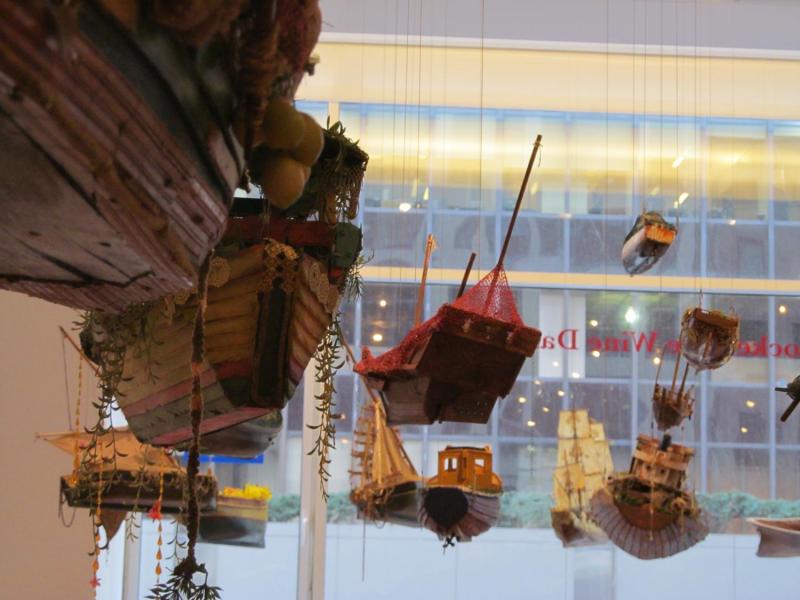
Nave (as in a church) has as its root the Medieval Latin word for ship, “navis.” The etymology cues a tradition dating back to at least the fifteenth century: Survivors of shipwrecks and captains prosperous at sea would donate miniature models of boats to churches. Hung from the eaves of European—particularly Scandinavian—cathedrals, these votive boats were a form of thanks but also prayer. They’ve inspired art before, Renaissance painter Vittore Carpaccio’s “The Apparition of the Ten Thousand Martyrs,” for one. British artist Hew Locke didn’t know of the boats until encountering them in a Portuguese fisherman’s chapel in 2009. Ships had long been in his visual vocabulary, but in that sacred setting he saw them anew: In constellation, in the context of journeys so difficult they require either pleas or gratitude to the gods.
That lens illuminates his work, most recently with the flotilla of thirty-five boats that hang from the ceiling at Manhattan’s Edward Tyler Nahem Fine Art gallery. Cruise ships, gold-filigreed galleons, a Coast Guard boat, a dugout canoe, and sailboats all careen together in suspended motion, in an installation consecrated to refugees from Syria and Iraq. Locke christened it “The Wine Dark Sea” in homage to Homer’s “Odyssey” but also to Derek Walcott’s epic poem “Omeros,” which recasts the ancient Greek tale in the Antilles. The title “bends together two seas,” Locke tells me—the Caribbean and the Mediterranean, both scenes of precarious migrant crossings.
His makeshift barge curtained with doll’s clothes, inspired by a Coast Guard photo of a Cuban refugee boat, also holds as cargo an old Iraqi Army badge to allude to the more recent crisis. Secreted inside or painted on hulls, totems gather from boat to boat as refrain, as excess imagery: UN and NATO coins, burlap sacks known in Africa as migrant’s bags, fisherman’s nets, outlines of skulls, metallic cutouts of gunmen. The last hint at “what people are running from.” Vine-like plastic flowers evoke altars.
“It’s a votive thing, almost a protective device,” Locke says.

Locke was born in Edinburgh, where his father, sculptor Donald Locke, was getting his MFA. At the time, when flights weren’t everyman excursions, to migrate was to know boats. Donald Locke had arrived in England by one, during the period that saw the first significant Caribbean immigration to Britain. The era itself was named after a boat: the Windrush, the retired cruise ship that brought the first arrivals, 492 Jamaicans, many of whom were ex-RAF fighters, to the imperial metropolis in 1948. By the time hostility against newcomers crested two decades later, with the nativist Enoch Powell threatening a “river of blood,” Hew had made his “fancy dress” passage across the Atlantic to Guyana.
The name of the country we share translates as “land of many waters.” During his years there, the muddy ocean tides, three mighty rivers, innumerable sweet-water creeks, and the unending canals that cut through the plantations all fulfilled their chances for ships: ferries, pontoons carrying cane, fishing skiffs, ocean liners—and the toy boats that Hew would float in gutters running through his neighborhood in the Guyanese capital. Boats take him to a nostalgist’s country: Suddenly he can smell the grease on the anchor ropes of the inland ferries he rode as a boy.
Family holidays were spent in the South American nation’s remote interior, its otherworldly forests and mountains muse for Sir Arthur Conan Doyle’s Lost World and Sir Walter Raleigh’s fevered dreamland of gold, an El Dorado unreachable except by boat. Locke recalls traveling home from one jaunt on a boat transporting caged tropical birds for commercial export. The boatmen would occasionally throw a dead parrot or songbird overboard. Even on childhood pleasure trips, boats offered him intimations of mortality and abridged freedom.
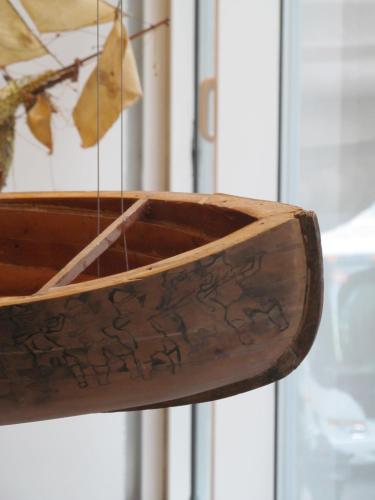
Since then, he tells me, “I would make a boat every two years.” The impulse goes deeper than the psyche of a son of the Atlantic slave trade, or even of a migrant or artist, to a basic humanity. We feel for boats in a way we don’t for planes. “Boats,” Locke says, “are much closer to our hearts in a way, in carrying people around for thousands of years.”
I tell him of their mythic place in my own imagination, in my history of indentured Indians shipped to West Indian plantations to replace freed Africans. I spin my creation story for him: Indo-Caribbeans as a people began on the seas. What was prologue? Where was? Like time and space before the Big Bang, it’s unfathomable. No place of return; in our beginning, only a boat. // This summons for Locke a memory of a trip to Guyana thirty years ago. Along Georgetown’s seawall, he found Rastafarian friends building a boat to take them to Africa. “I remember thinking it looked scary,” he says. “It was well built for a river, but to go across the Atlantic Ocean—that was insane.”
“The physical object embodied a hope?” I ask.
“The physical object was for them a very serious idea: You have to go back to Africa. It was more of a dream than a hope.”
That boat never did go to Africa but Locke couldn’t forget it. The faith in escape, a reminder that boats mean life as much as death, inspired a boat in the Manhattan exhibit, one bright with Rastafarian colors.
There are no slave ships in the exhibit. Only one boat, a canoe Locke bought on eBay, suggests the Middle Passage. On its hull, he painted the famous sculpture of a soldier in bronze, given by Portugal to its African trading partners, the Benin kings who sold slaves for brass and arms. On the hull, the soldier repeats itself, in imitation of the iconic diagram of slaves stacked claustrophobically side by side as cargo.
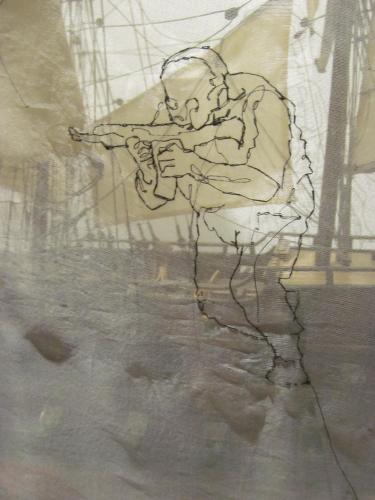
It reminds me of another boat burdened by history: the Sun Chapman, a launch that sank in an explosion near a downriver mining town in Guyana in 1964, on the eve of independence, a time of haunting racial violence between the descendants of the enslaved and the indentured. Locke, who arrived in Guyana as it became free, says watching a country being born deeply affected his work. He’s intrigued by “visual expressions of nationhood and power,” such as queens’ heads, flags, coats of arms and currency designs. Coins are tucked inside boats throughout the installation. Locke had not, however, heard of the Sun Chapman.
Forty-three people, all black, died during its explosion. It took place soon after a campaign of arson, murder, and rape that forced most of the town’s Indians to flee. (Several were killed.) The sinking was rumored retaliation. Growing up, I had heard of the ethnic cleansing. I had not heard of the Sun Chapman until I visited a museum in the mining town last year. The ship was memorialized there. The exodus of Indians was not. Traumatic histories are repressed ones, selectively remembered.
Had he known about the Sun Chapman, Locke would not have used it. It’s a painful symbol of continuing animosity. We walk past a gray barge in the installation. Heaped inside are gold-colored WWII battleships, which it’s carrying away, elegiacally enacting the loss of a golden era. Nearby lies an upside-down boat with skeletons painted on the underside, hung below an oil tanker. “This is what lies beneath, the wreckage of the past,” Locke says.

We’re all in the same boat. The cliché to express solidarity is nautical. As Locke puts it, “all your GPS in the world is not going to save you if a storm kicks in.”
For both artist and migrant, ships are symbols of the universal. A slave, an indentured servant, a tourist, a seaman, a refugee obviously each inhabit a ship distinctly, but aboard, each is ultimately at the mercy of the sea. I share Locke’s instinct for seeking comrades in the hull’s curve. In my own work, I present indenture voyages and slave journeys in parallel.
I tell Locke of an electrochemical moment at a recent reading in New York. In 1914, 376 Punjabis were virtually imprisoned for two months on the steamship Komagata Maru, docked in Vancouver, because of racist exclusion laws. In 1781, the crew of the Zong threw 133 slaves overboard; the owner said there wasn’t enough water for all and, then, claimed the insurance for each. Poets Phinder Dulai and NourbeSe Philip gave breath and resurrection to those stories side by side at the Asian American Writers’ Workshop. They even swapped words. Philip spoke Dulai’s (“dream arteries surge seaward / pistons beat, engines screech”) and he spoke hers (“negroes want water / overboard/”).
Locke tells me the Zong has haunted him, too. He carved it, as part of a sculpture in England to celebrate the Magna Carta. Despite the tragedies of empire and bondage allied with boats, Locke tells me—he almost confesses—that he works with them because he finds them elegant, as aesthetically pleasing as any muse. “I was trying to make a beautiful object, really,” he explains. “The boats aren’t dark things. The subject matter may be tricky but the boat itself is a beautiful thing. I wouldn’t be working with these if I didn’t find them attractive.”
Their stories, he insists, are of life as much as death. “These are things of safety,” he says. “The life source is not necessarily land but another bigger boat coming to save you.”
These dispatches are from #VQRTrueStory , our social-media experiment in nonfiction, which you can follow by visiting us on Instagram: @vqreview .

Gaiutra Bahadur
Gaiutra Bahadur is the author of Coolie Woman: The Odyssey of Indenture (University of Chicago Press, 2013), which was shortlisted for the 2014 Orwell Prize. Her reporting, criticism, and essays have appeared in the New York Times Book Review , the Nation , Dissent , Foreign Policy and Ms. , among other publications. She is a MacDowell Colony Fellow, a Nieman Fellow, a New Jersey State Council on the Arts Fellow, and the 2016-2017 Sheila Biddle Ford Foundation Fellow at Harvard University’s Hutchins Center/DuBois Institute.
- Print Article
Most Popular
The male glance, prince of peace, fear factors, omnipresence.
You have read 1 of 10 free articles in the past 30 days
Get unlimited access
Recommended Reading

Democracy, Debates, and Daughters
By Siva Vaidhyanathan

Night Moves
By Amanda Petrusich

Mysterious American Cat
By Ryan Bradley

Once Bitten
By Laura Kolbe

But I’ve Got Ovid
By Jane Alison
- The Collection
- The American Wing Ancient Near Eastern Art Arms and Armor The Michael C. Rockefeller Wing Asian Art The Cloisters The Costume Institute Drawings and Prints Egyptian Art European Paintings European Sculpture and Decorative Arts Greek and Roman Art Islamic Art Robert Lehman Collection The Libraries Medieval Art Musical Instruments Photographs Antonio Ratti Textile Center Modern and Contemporary Art
Crop your artwork:
Scan your QR code:
Gratefully built with ACNLPatternTool
The Wine Dark Sea, H
Hew Locke British
Not on view
The Wine Dark Sea , by British-Guyanese artist Hew Locke, is an installation comprised of seven individual sculptures, five of which premiered at his 2016 exhibition at Edward Tyler Nahem Fine Art in New York City. The title of the installation is a nod to Homer’s Illiad and Odyssey (both of which use a Greek epithet that serves as the installation’s title) as well as to Derek Walcott’s epic poem Omeros , from 1990, itself a reference to Homer, albeit one that plays out in the Caribbean instead of the Aegean. Crafted from wood, metal, fabric, and found materials, each sculpture in The Wine Dark Sea takes the form of a vessel which is in turn based on a particular prototype. The Wine Dark Sea, U references a Coast Guard skiff. The Wine Dark Sea, AA , takes its inspiration from a more pedestrian sailing boat. The Wine Dark Sea, CC alludes to a stock military boat. The Wine Dark Sea, DD is a model of Sir Francis Drake’s The Revenge, a flagship pitted against the Spanish Armada. (This sculpture evokes more generally the large sailing galleons of the age of discovery and conquest in the 15th through the 18th centuries). The Wine Dark, H is based on a Cuban refugee boat. Boat X (from The Wine Dark Sea, Group 9) is inspired by the boats deployed in the 1979 film Apocalypse Now , the same sorts of vessels employed on military and colonial expeditions around the world. Finally, Boat F (from The Wine Dark Sea, Group 6) typifies the kind of cargo transport used along the Amazon, the site of extractive industries as well as colonial enterprise. Most of the sculptures are embellished with a profusion of chains, plastic flowers, national and organizational coins, medals, imperial regalia, military uniform badges, and the like, all of it rife with historical and symbolic import. A brass plaque on one of the ships alludes directly to a 16th-century German carving of a skeleton, for instance, while another, on The Wine Dark Sea, DD evokes the Queen Mother Pendant Mask , a 16th century ivory mask from Benin, an example of which is in The Met’s collection. The addition of cargo sacks, bags, and clothing suggests the presence of crew members who are otherwise absent. This, in turn, evokes mysterious, perhaps fatal events left to the imagination. Locke’s sculptures are meant to hang from the ceiling, creating a dense, fantastical installation—a kind of suspended flotilla that immerses viewers in both art and history. Like ships themselves, Locke’s procession conjures up a variety of narratives around maritime trade and exchange as well as migration, displacement, slavery, smuggling, colonialism, and military conflict. Locke has referred to sculptures such as these as "votive ships," both "offerings and invocations"[1] inspired by the x-votos he encountered in churches in the Caribbean and beyond. Together and individually, The Wine Dark Sea speaks to the events and catastrophes, many of them involving displaced, disenfranchised peoples of the world, that have taken place on the planet’s many bodies of water. [1] Zoe Lukow, Hew Locke: The Wine Dark Sea [brochure] (New York: Edward Tyler Nahem Fine Art, LLC, 2016), p. 3.
Due to rights restrictions, this image cannot be enlarged, viewed at full screen, or downloaded.
Open Access
As part of the Met's Open Access policy , you can freely copy, modify and distribute this image, even for commercial purposes.
Public domain data for this object can also be accessed using the Met's Open Access API .
- https://www.metmuseum.org/art/collection/search/739594 https://www.metmuseum.org/art/collection/search/739594 Link copied to clipboard
- Animal Crossing
- Download image
- Enlarge image
Artwork Details
Use your arrow keys to navigate the tabs below, and your tab key to choose an item
Title: The Wine Dark Sea, H
Artist: Hew Locke (British, born 1959)
Medium: Mixed media
Dimensions: 34 1/4 × 32 1/2 × 14 1/2 in. (87 × 82.6 × 36.8 cm) Weight:: 4.9 lb. (2222.625g)
Classification: Sculpture
Credit Line: Purchase, Modern Circle and William Talbott Hillman Foundation Gifts, 2017
Accession Number: 2017.340
Rights and Reproduction: © Hew Locke 2016
Learn more about this artwork
Related artworks.
- All Related Artworks
- By Hew Locke
- Modern and Contemporary Art
- Mixed media
- From Europe
- From United Kingdom
- From A.D. 1900–present
The Wine Dark Sea, U
Boat X (from The Wine Dark Sea, Group 9)
The Wine Dark Sea, DD
Boat F (from The Wine Dark Sea, Group 6)
The Wine Dark Sea, AA
Resources for research.
The Met's Libraries and Research Centers provide unparalleled resources for research and welcome an international community of students and scholars.
The Met Collection API is where all makers, creators, researchers, and dreamers can connect to the most up-to-date data and public domain images for The Met collection. Open Access data and public domain images are available for unrestricted commercial and noncommercial use without permission or fee.
We continue to research and examine historical and cultural context for objects in The Met collection. If you have comments or questions about this object record, please complete and submit this form . The Museum looks forward to receiving your comments.

Modern and Contemporary Art at The Met
North West Island to Airlie
Sorry it has taken me so long to get around to this post. It’s not like I can blame my hectic lifestyle. My pilgrimage to Sarah’s resting place complete, I was called back to reality by the need to get back within communication range for a video conference the next morning. I weighed anchor and […]
Bundaberg to North West Island
I had been weighing up a few options for this next leg. Do I do a short hop to Pancake Creek or Lady Musgrave? Or a longer leg directly to North West Island. Frankly it came down to not wanting to spend any more time with my keel in the mud at Bundberg. At its […]
Mooloolaba to Bundaberg
With the handover of the Sydney Football Stadium imminent, I could start my long 2 months of live-aboard. Joining me for that last overnight passage for a while, around Fraser Island, was long time crew and ex-work colleague Doug Rayment and girlfriend Sascha EE. This would be the first overnight sea passage on a sailing […]
Southport to Mooloolaba
Lindy Hardcastle joined me for the short trip from Southport to Mooloolaba. I flew up on Sunday morning and met up with my uncle, Steve, and my cousin, Sean. The later of which works for Riviera yacht on the Gold Coast. The place was pumping, so much so the yacht club couldn’t accommodate us for […]
Sydney to Southport Solo
This year the delivery of Wine-dark Sea to Queensland for Airlie beach race week and magnetic island race week is being juggled with the final commissioning of the new Sydney football stadium. Eyeing up a potential 5 day weekend without commissioning and a favourable weather window, on the tail of a southerly blast, I decided […]

Getting ready to rumble…
It feels great to be getting back into the routine. As departure approaches I’m now in my route planning routine. Every 12 hours, when the new forecasts are released, I download the 6 models from Predictwind and import them into Expedition to run my optimized routes at 6 hour departure times. Currently I’m debating slightly […]
Modifications aplenty. Some planned, some not so much
So long since my last post. Well I didn’t seem to get out much on the boat over summer. Not really sure why. The general blur of the last 2 years of the ‘rona has me wondering what exactly I have done with the last 2 years. I even had to Google when we came […]
Here we go again…
…a little scaled back though. Today we finally start the 2021-2022 sailing season. I’ve decided to back my racing off for a few reasons, so I am only planning to do Friday twilights. I might throw in a regatta here and there depending on crew interest. One of the main reasons was that over the […]
Sorry its been so long…
….but COVID has made a right mess of things for all of us hasn’t it. So what’s been happening? (I can’t believe my last post was for Sarah’s birthday last year) At that time I was newly installed in my brand-new-second-hand apartment in Dee Why. I’m well settled in now and have ripped up the […]
Happy Birthday Sarah
Today would have been Sarah’s 56th birthday. Today I feel her loss as keenly as the day she was taken from us all too soon. I can’t help but think what we would have been doing. I suspect we would have, as I have this morning, gone down and watched a beautiful sunrise over the […]

- Already have a WordPress.com account? Log in now.
- Subscribe Subscribed
- Report this content
- View site in Reader
- Manage subscriptions
- Collapse this bar

a journal of research & art
- Contributors
- How to Cite EuropeNow
- Special Features
- Special Series
- Call for Applications: EuropeNow Editorial Committee
- Current Issue
- Past Issues
- Editor’s Pick
- COVID-19 Series
- Ukraine Series
- Sponsored Research
- The Borders Project
- Favorite Books in Translation
- Campus Spotlights
- Campus Dispatches
- Campus Book Reviews
- Campus Interviews
- Special Campus Series
- Campus Round-Up
- Assessments & Lesson Plans
- Student Contributions
- CES-Sponsored Student Research
- Digital Classroom
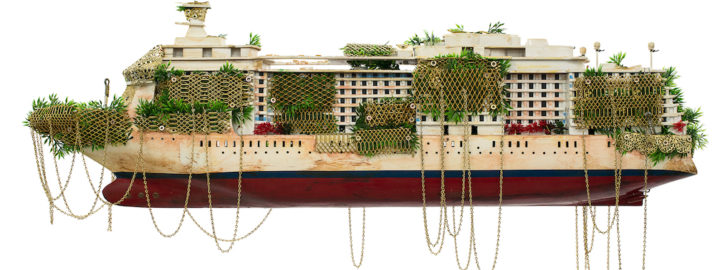
The Wine Dark Sea
This is part of our special feature, Networks of Solidarity During Crises.
“The Wine Dark Sea” is a description of the Mediterranean used by Homer throughout The Odyssey, and the phrase is repeated by Derek Walcott in his epic poem Omeros, set mainly in the Caribbean and referencing characters from The Iliad. This visual poem incorporates customised models of contemporary and historically resonant vessels—clippers and cargo ships, battleships and lifeboats—filled with hope, potential prosperity, and gratification, as well as despair, anguish, and suffering. A ship is a symbolic object; vessel of the soul, means of escape, both safety and danger. No crew are visible—the boats themselves stand for crew and passengers.
“The Wine Dark Sea” is a selection of up to thirty-four boats, either hanging or on strands, ranging from 23 to 183 cms in length.
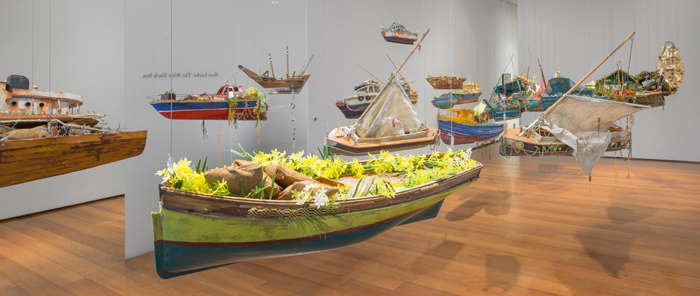
Hew Locke was born in Edinburgh, UK, in 1959; lived from 1966 to 1980 in Georgetown, Guyana; and is currently based in London. He obtained a B.A. Fine Art in Falmouth (1988) and an M.A. Sculpture at the Royal College of Art, London (1994). In 2000 he won both a Paul Hamlyn Award and an East International Award . His work is represented in many collections including those of the The Government Art Collection, The Pérez Art Museum Miami, The Tate Gallery, The Arts Council of England, The National Trust, The Metropolitan Museum of Art, New York, The Brooklyn Museum, New York, 21c, The New Art Gallery Walsall, The Victoria & Albert Museum, The Imperial War Museum, The British Museum and The Henry Moore Institute, Leeds.
These images are Courtesy of Hew Locke and P·P·O·W, New York Published on October 13, 2020.
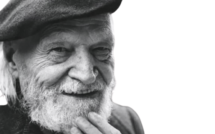
Allegria by Giuseppe Ungaretti
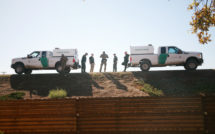
Bard College Border Pedagogy: Experiential Learning, Syllabi, and a Model…

© 2016-2024 EuropeNow. All Rights Reserved.
C larkesworl D
Science fiction & fantasy magazine.

- Back Issues
- Cover Gallery
- Submissions
- Mailing List
- Advertising
FOLLOW US ON
Issue 76 – January 2013
Non-Fiction
The Wine-Dark Sea: Color and Perception in the Ancient World
by Erin Hoffman
“And jealous now of me, you gods, because I befriend a man, one I saved as he straddled the keel alone, when Zeus had blasted and shattered his swift ship with a bright lightning bolt, out on the wine-dark sea.” —Homer, The Odyssey, Book V
Perception is a funny beast. Homer’s “wine-dark sea” has puzzled scholars for centuries , leading to such far-flung hypotheses as strange weather effects, air pollution, and mass Grecian color-blindness .
It’s a phrase repeated in the works of W. H. Auden, Patrick O’Brian, and Brian Jacques, among others. Reading it today, we naturally assume that it is intended as allegory, some evocative reference to the sea’s mystery, its intoxication.
We may never know for sure, but one peculiar fact casts the mystery in an interesting light: there is no word for “blue” in ancient Greek.
Homer’s descriptions of color in The Iliad and The Odyssey, taken literally, paint an almost psychedelic landscape: in addition to the sea, sheep were also the color of wine; honey was green, as were the fear-filled faces of men; and the sky is often described as bronze.
It gets stranger. Not only was Homer’s palette limited to only five colors (metallics, black, white, yellow-green, and red), but a prominent philosopher even centuries later, Empedocles, believed that all color was limited to four categories: white/light, dark/black, red, and yellow. Xenophanes, another philosopher, described the rainbow as having but three bands of color: porphyra (dark purple), khloros, and erythros (red).
The conspicuous absence of blue is not limited to the Greeks. The color “blue” appears not once in the New Testament, and its appearance in the Torah is questioned (there are two words argued to be types of blue, sappir and tekeleth, but the latter appears to be arguably purple, and neither color is used, for instance, to describe the sky). Ancient Japanese used the same word for blue and green (青 Ao ), and even modern Japanese describes, for instance, thriving trees as being “very blue,” retaining this artifact (青々とした: meaning “lush” or “abundant”).
It turns out that the appearance of color in ancient texts, while also reasonably paralleling the frequency of colors that can be found in nature (blue and purple are very rare, red is quite frequent, and greens and browns are everywhere), tends to happen in the same sequence regardless of civilization: red : ochre : green : violet : yellow—and eventually, at least with the Egyptians and Byzantines, blue.
“Why then 'tis none to you; for there is nothing either good or bad, but thinking makes it so.” — Hamlet, Act 2, Scene 2
Blue certainly existed in the world, even if it was rare, and the Greeks must have stumbled across it occasionally even if they didn’t name it. But the thing is, if we don’t have a word for something, it turns out that to our perception—which becomes our construction of the universe—it might as well not exist. Specifically, neuroscience suggests that it might not just be “good or bad” for which “thinking makes it so,” but quite a lot of what we perceive.
The malleability of our color perception can be demonstrated with a simple diagram, shown here as figure six, “Afterimages” . The more our photoreceptors are exposed to the same color, the more fatigued they become, eventually giving out entirely and creating a reversed “afterimage” (yellow becomes blue, red becomes green). This is really just a parlor trick of sorts, and more purely physical, but it shows how easily shifted our vision is; other famous demonstrations like this selective attention test (its name gives away the trick) emphasize the power our cognitive functions have to suppress what we see. Our brains are pattern-recognizing engines, built around identifying things that are useful to us and discarding the rest of what we perceive as meaningless noise. (And a good thing that they do; deficiencies in this filtering, called sensory gating, are some of what cause neurological dysfunctions such as schizophrenia and autism.)
This suggests the possibility that not only did Homer lack a word for what we know as “blue”—he might never have perceived the color itself. To him, the sky really was bronze, and the sea really was the same color as wine. And because he lacked the concept “blue”—therefore its perception—to him it was invisible, nonexistent. This notion of concepts and language limiting cognitive perception is called linguistic relativism, and is typically used to describe the ways in which various cultures can have difficulty recalling or retaining information about objects or concepts for which they lack identifying language. Very simply: if we don’t have a word for it, we tend to forget it, or sometimes not perceive it at all.
The famed neuroscientist Dr. Oliver Sacks (you might know him as Robin Williams’s character in Awakenings ) described a poignant example of linguistic or conceptual relativism with regard to schizophrenia. Accounts of the disease prior to the 19th century are rare, and none at all exist in ancient literature (as opposed to “madness,” which was documented, but primarily concerned aimless wandering and spontaneous violence). The broad classification of “madness” persisted well through the 19th century, with schizophrenia identified in the early twentieth, and still considered rare through the middle of the century. When Sacks began practicing in 1965 in New York City, and in particular began studying disorders related to schizophrenia, he was shocked by a gradually increasing awareness that the disease was not nearly as rare as the science of the day claimed—especially among the homeless. Importantly, the clinical assumption that “schizophrenia is rare” was reinforcing the rarity of its diagnosis, to the point of blinding doctors to what was right in front of them. These blooms in diagnosis—we have been for the last ten years experiencing a bloom in autism recognition—have as much to do with clinical perception as they do with the actual physical incidence of the conditions.
On a lighter note, Sacks also recently recalled that the most magnificent thing he had ever seen in his life was a field of yellow, seen while he was—is it appropriate to say a famous neuroscientist was high ? Say rather that he was conducting experiential research in a varied state of neurochemical condition! But however you slice it, he says it was the most yellow yellow he had ever seen or expects to see again, a yellow beyond description, a yellow of interstellar radiance and the breath of ancient gods.
It isn’t the first time that Dr. Sacks has discussed color and altered states: in “The Dog Beneath the Skin,” he tells the infamous story of the 22-year-old medical student who, under the influence of PCP and amphetamines, enters a week-long heightened state of awareness. Among other things, this student—decades later revealed to have been Sacks himself, of course—perceived “dozens of browns” where previously he had seen only one shade. (Dr. Sacks does not now recommend this type of student experimentation.)
This particular super-sensory color perception is, too, reminiscent of another physical condition related to color: tetrachromacy. Most humans are trichromatic, possessing three types of color-sensing cone cells—but an undetermined percentage of women, as well as almost all birds, are tetrachromatic, possessing four receptor types. Tetrachromats perceive a kind of fourth primary color, usually a blue-green, that gives them a heightened ability to distinguish between shades of color, often to the point of distinguishing separate shades where a trichromat will perceive identicality.
“The evolution of sense is, in a sense, the evolution of nonsense.” —Vladimir Nabokov, novelist, synesthete
We need not travel far to determine whether these enhanced states of perception—which, given that we remain the same species as Homer, can be societal or psychological in their impetus—can impact our worldview, or our creative selves.
We know that people with synesthesia , a neurological anomaly in which one sensation “bleeds” into other sensations, are eight times more likely to pursue careers in the arts than non-synesthetes. Synesthesia comes in many varieties, but those with a visual variant (for instance perceiving numbers and letters in colors) are more likely to become visual artists—or novelists.
Vladimir Nabokov, novelist and synesthete, wrote his synesthesia into his characters on occasion, and some of his descriptions—such as the word “loyalty” suggesting “a golden fork lying in the sun”—indicate that this crossing of senses, infused with color, certainly influenced Nabokov’s construction of language. Words themselves could be beautiful or garish depending upon their letter-level construction.
Some scientists have postulated that this phenomenon of carrying meaning from one sense into another—which is essentially the definition of a metaphor—is universal and contains insight into the deepest workings of our minds. In the case of the common grapheme-color synesthesia, such as Nabokov’s, a likely explanation is the close proximity of portions of the fusiform gyrus that deal respectively with word and color recognition in the brain. When a synesthete reads a word, some of the electrical energy from that word-recognizing region is possibly leaping over into that color recognition region. One remarkable side effect of this is that many synesthetes tend to perceive the same colors for letters (“A” tends to be red), which underscores the structural theory—and might suggest that this same phenomenon is at work in all of us below the level of our conscious awareness.
While the causes of synesthesia remain unknown, it is generally agreed that the physical basis is a kind of excess of interconnectedness between neurons. It may be that the “pruning” we undergo as children does not complete, leaving connections behind that in the mainstream population are eradicated—but provoked synesthesia in the cases of drug use or epileptic seizures suggest that non-synesthesian brains are capable of synesthetic effects.
A 1929 experiment by Gestalt psychologist Wolfgang Köhler elegantly illustrates what some call our natural synesthesia. Köhler drew two random shapes: one spiky and sharp, the other flowing and rounded. He then asked subjects to guess of these shapes which one was called “kiki” and which was called “bouba.” The results were very clear: 95-98% of subjects identified the sharp shape as “kiki” and the rounded shape as “bouba.” (Fascinatingly, autistic individuals make this match only 56% of the time.)
Köhler’s experiment wrapped science around what we would call onomatopoeia: when a word sounds like what it is. But onomatopoeia is by definition synesthesia, the transference of sound into orthogonal meaning.
The modern neuroscientist Dr. Vilayanur Ramachandran suggests that Köhler’s experiment shows that, to a certain extent, we are all synesthetes, and further that this inherent interconnection between our cognitive functions is intrinsic to the most beloved traits of humanity: compassion, creativity, ingenuity. What, after all, is an idea, but one flash of thought leaping across the mind to suggest novel possibility?
“The aim of art is to represent not the outward appearance of things, but their inward significance.” —Aristotle
So, if we’re all synesthetes, and our minds are extraordinarily plastic, capable of reorienting our entire perception around the addition of a single new concept (“there is a color between green and violet,” “schizophrenia is much more common than previously believed”), the implications of Homer’s wine-dark sea are rich indeed.
We are all creatures of our own time, our realities framed not by the limits of our knowledge but by what we choose to perceive. Do we yet perceive all the colors there are? What concepts are hidden from us by the convention of our language? When a noblewoman of Syracuse looked out across the Mare Siculum, did she see waves of Bacchanalian indigo beneath a sunset of hammered bronze? If a seagull flew east toward Thapsus, did she think of Venus and the fall of Troy?
The myriad details that define our everyday existence may define also the boundaries of our imagination, and with it our dreams, our ethics. We are lenses moving through time, beings of color and shadow.
Erin Hoffman
Erin Hoffman is an author and game designer from California. Her fantasy series The Chaos Knight completes with its third volume, Shield of Sea and Space, in May 2013 from Pyr Books.
PURCHASE THIS ISSUE:
Amazon Kindle
Amazon Print Edition
Weightless EPUB/MOBI

Audio Fiction
Awards & Recognition
Authors & Artists
Random Story
Random Podcast
Follow Us On
SUBSCRIBE AT
B&N Nook Newsstand
ClarkesworldCitizens
Weightless Books
ISSN 1937-7843 · Clarkesworld Magazine © 2006-2024 Wyrm Publishing. Robot illustration by Serj Iulian.

The Caribbean Commons
Caribbean Studies in the Northeast US
Hew Locke: The Wine Dark Sea
Hew Locke’s first solo exhibition in New York 24 February – 1 April 2016
Edward Tyler Nahem Fine Art 37 West 57th Street, 2nd floor, New York, NY 10019 Ph 212 517 2433 [email protected] Hours: Monday-Friday 10am-5:30pm.
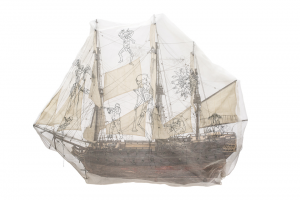
Edward Tyler Nahem is pleased to present Hew Locke’s first solo exhibition with the gallery. The Anglo-Guyanese artist who lives in Great Britain and spent his formative years in Guyana, consistently explores themes of race, colonialism, displacement, the creation of cultures, and the visual codes of power, drawing on a deeply personal visual language.
Hew Locke: The Wine Dark Sea will present new works by the artist that highlight Locke’s acclaimed sculptures of boats, which occupy an important place in his personal iconography. ‘The wine dark sea’ is a description of the Mediterranean used by Homer throughout The Odyssey, and the phrase is repeated by Derek Walcott in his epic poem Omeros set mainly in the Caribbean, and referencing characters from The Iliad. Locke’s visual poem likewise points up the universality of many of our experiences.
This new series of twenty-five vessels of varied scale and hues will be suspended from the ceiling, creating a flotilla at eye level. Incorporating contemporary and historically resonant vessels – clippers and container ships, battleships and lifeboats – Locke will create a spectacular sculptural environment. Locke’s work articulates this environment as filled with hope, potential prosperity and gratification, as well as despair, anguish, and suffering. This narrative resonates deeply with the tides of refugees fleeing to the sea from war, oppression, and poverty, but also with those viewers for whom migration and displacement are part of family history. A ship is a symbolic object; vessel of the soul, means of escape, both safety and danger. According to Locke, “We’re all floating on the same ocean. As a child and young man I sailed the Atlantic. At sea, a twist of fate can send a super-yacht down – it can be an equalizer between rich and poor.”
Locke’s multi-media practice includes large-format installation, painting, sculpture, photography and tapestry and has been called a “’mental Moulinex,’ or food processor, into which experiences are tossed, mixed around, and transformed into chimerical creations.” (ArtNews, April 2014). Related works include his celebrated For Those in Peril on the Sea, 2011, in the collection of the Peréz Art Museum Miami and The Tourists, 2014, an installation commissioned by the Imperial War Museum for the museum ship HMS Belfast, London.
Born in Scotland, Locke grew up in Georgetown, Guyana before returning to Britain for his university education. His work has been exhibited around the globe, most recently at Tate Britain, and in Runnymede, UK where he was commissioned to make a permanent memorial to celebrate the 800th anniversary of the signing of the Magna Carta. Locke’s work is represented in the collections of Tate Gallery (UK), the Brooklyn Museum (New York), the Kemper Museum of Contemporary Art (US), Kansas City Collection (US), the RISD Museum (Rhode Island), Victoria & Albert Museum (London), and the British Museum (London) amongst others.
Image above – The Wine Dark Sea , (boat BB), 2016, mixed media with custom hand embroidery, 76 x 33 x 98cm
Above adapted from press release and email announcement.
Need help with the Commons?
Email us at [email protected] so we can respond to your questions and requests. Please email from your CUNY email address if possible. Or visit our help site for more information:

- Terms of Service
- Accessibility
- Creative Commons (CC) license unless otherwise noted


Hew Locke: The Wine Dark Sea
February 24 – april 13, 2016.
Hew Locke The Wine Dark Sea, W , 2016 Mixed media 23 1/8 by 49 5/8 by 42 1/8 inches (58.5 x 126 x 107 cm)
Hew Locke The Wine Dark Sea, Group 2 , 2016 Mixed media Boat A: 12 1/4 by 26 3/8 by 9 1/2 inches (31 x 67 x 24 cm); including chains: 36 1/4 inches (92 cm) H Boat E: 11 3/4 by 24 1/8 by 9 1/8 inches (30 x 61 x 23 cm)
Hew Locke The Wine Dark Sea, Group 1 , 2016 Mixed Media Boat FF: 7 5/8 by 21 5/8 by 8 1/4 inches (19.5 x 55 x 21 cm) Boat Z: 14 3/4 by 48 7/8 by 10 1/8 inches (37.5 x 124 x 25.5 cm)
Hew Locke Ghost , 2015 Wood, tin panels, chain, plastic flowers, spray-paint,varnish, resin, superglue, enamel paint, brass wire. 31 1/2 by 63 by 8 3/4 inches (80 x 160 x 22 cm); including chains: 42 1/2 inches (108 cm) H
Hew Locke The Wine Dark Sea, V , 2016 Mixed media 10 3/8 by 25 1/4 by 7 3/8 inches (26.5 x 64 x 18.8 cm)
Hew Locke The Wine Dark Sea, BB , 2016 Mixed media 30 by 38 5/8 inches by 13 (76 x 98 x 33 cm)
Hew Locke The Wine Dark Sea, DD , 2016 Mixed media 34 5/8 by 28 3/4 by 15 3/8 inches (88 x 73 x 39 cm)

April 16, 2024 76 °F PBS Passport .st0{fill:#0A145A;} .st1{fill:#5680FF;} .st2{fill:#FFFFFF;} UH Search for: Search MENU CLOSE News & Information Features Hello Houston inDepth Topics Local News Statewide News Business Education News Energy & Environment Health & Science Immigration Politics Transportation All Stories >>> Arts & Culture Arts & Culture Main Classical Music Music Opera & Musical Theater Dance Visual Art Literature Theatre & Film Voices and Verses: A Poem-A-Day Series Awareness Hispanic Heritage Pride Month: Better Together! Asian American Pacific Islander Heritage Black History Women’s History Education Programs & Podcasts Local Programs Party Politics Houston Matters with Craig Cohen I SEE U with Eddie Robinson Texas Standard UH 100 Years of Houston Bauer Business Focus Briefcase Engines of Our Ingenuity Health Matters UH Moment Features Dead and Buried Career Frontier Podcasts Below the Waterlines: Houston After Hurricane Harvey Party Politics Skyline Sessions Encore Houston All Podcasts >> Support Membership Update Payment Method Upgrade Your Monthly Gift Give a Gift Membership Giving Programs Affinity Council Studio Society In Tempore Legacy Society Innovation Fund Volunteers Foundation Board Young Leaders Council Mission Ambassadors Donations Thank-You Gifts Vehicle Donation Giving Opportunities Employee Match Program More Ways to Give Partnerships Corporate Sponsorship About About Us Meet the Team Join the Team Contact Us Ethics and Standards Reports & Financials Press Room Listen Watch Donate Facebook Twitter Instagram YouTube Linkedin Mastodon Houston Matters is on the air now! Join the conversation: Email [email protected] | Listen Live googletag.cmd.push(function() { googletag.display('div-gpt-ad-1488818411584-0'); }); This article is over 7 years old Classical Music
Sailing the wine-dark sea with composer john mackey.
John Mackey talks about his symphony for band inspired by The Odyssey, as well as his compositional process, what music he listens to, and his cat.
To embed this piece of audio in your site, please use this code:

"My wife and I collaborate on all of the pieces that I write, and in this case she suggested that because this was a large thirty-minute piece, I should base it on the original epic story, which was The Odyssey by Homer that's thousands of years old," says composer John Mackey about his symphony for band: Wine-Dark Sea .
Mackey is widely known in the concert band world, and he has a large repertory of works for that ensemble with pieces like the sultry Redline Tango to the hopeful and bright Aurora Awakes . One of the things that appeals to him about concert band literature is that "most ensembles are university-based, [and] they have so much rehearsal time!"
And all of that rehearsal time over a number of weeks, multiple times per week, culminates in a performance of Wine-Dark Sea by the Moores School Wind Ensemble this Friday. As mentioned above, this symphony for band (commissioned and premiered by Jerry Junkin and the University of Texas Wind Ensemble in 2014) is a programmatic representation of The Odyssey , with three movements ( I. Hubris ; II. Immortal thread, so weak ; and III. The attentions of souls ) that represent portions of Odysseus' journey back home after the Trojan War.
That concert takes place this Friday at 7:30 PM at the University of Houston's Moores Opera House. Hear my full conversation with John Mackey above, in which we talk about how he approaches his music, what other music he enjoys (from country music to Bernstein), and even a little bit about his cat Loki!
Excerpts featured in this segment are Wine-Dark Sea (Mackey) performed by the University of Texas Wind Ensemble with conductor Jerry Junkin (Reference Recordings 137) , Symphony No. 3 (Mahler) performed by the Vienna Philharmonic with conductor Pierre Boulez (Deutsche Grammophon 474038), Chichester Psalms (Bernstein) performed by the Israel Philharmonic Orchestra with the Vienna Boys’ Choir and conductor Leonard Bernstein (Deutsche Grammophon 463462), and Harmonielehre (Adams) performed by the San Francisco Symphony with conductor Edo de Waart (Nonesuch 79115) .
Resources like these are made possible by the generosity of our community of donors, foundations, and corporate partners. Join others and make your gift to Houston Public Media today! DONATE
Sign up for our daily weekday newsletter - hello, houston sign up now.
You are using an outdated browser. Please upgrade your browser or activate Google Chrome Frame to improve your experience.

Sailing the wine-dark seas
Published 6:59 pm Tuesday, August 29, 2023
By Staff reports

By John Nelson
The U.S. Merchant Marine Academy’s class of 1965 holds reunions every five years, and lately, we’ve started having mini-reunions in between. This year, about 20 gathered in Memphis for a cruise up the Mississippi.
Sign up for our daily email newsletter
Get the latest news sent to your inbox
Margaret and I couldn’t be away from home long enough for the cruise, but since the rendezvous point was the Peabody Hotel, we booked a room there, and during events at the hotel before they boarded the boat the next day, we had a chance to visit.
As one would expect when a group of old mariners get together, the talk is usually about ships, and I’m convinced that at least one in the class has served aboard most anything that floats.
The most interesting ship discussion was sparked by a classmate who was not in attendance but who had recently posted a message on the class email exchange. His email gave an account of his experiences in the late 1960’s aboard the SS Angelo Petri – the ex-Sackett’s Harbor.
When it comes to ship stories, there are some humdingers out there, and I’ve witnessed some first hand, but the Petri might take the cake as a ship that had a knack for survival.
She was launched in 1943 as the Sackett’s Harbor, one of a class of tankers known as T-2’s. Since these tankers were urgently needed during WWII, the high speed turbines drove an electrical generator that provided power to a motor that turned the propeller at the much slower speeds required. This propulsion system eliminated the need for reduction gears that take a long time to machine.
After the war, the ship entered commercial service, and on a routine voyage in 1946, she broke in half in rough seas about 800 miles southwest of Adax, Alaska. Ten men floated away with the forward section of the ship and were later rescued while the rest remained on the aft section that housed most of the living spaces and the engine room.
Things looked bad for a while, but the weather improved and the stern section remained seaworthy thanks to a watertight bulkhead. The engineers engaged the propeller in the astern rotation, and the deck officers backed the old girl all the way to Adax under her own power.
It would be a darn good sea yarn if it ended there, but it didn’t since the rapidly-growing town of Anchorage, Alaska, had no permanent source of electrical power. So instead of going to the scrapyard, the stern of the Sackett’s Harbor was towed to Anchorage where she provided the town with electricity until 1955 when hydro-electric power from the Eklutna Dam eliminated the need for her generator.
The aft section of the ship was once again facing the cutting torch when she got a reprieve from events unfolding to the south in the heart of California’s wine country.
The Petri’s of California were major promoters of the higher quality wines that were coming out of Napa Valley and finding favor among wine drinkers on the West Coast. By the mid-1950’s, the family business was managed by Louis Petri who hoped to expand the sale of California wines to eastern markets.
Transporting bottles of wine across the country was expensive since the railroads of the day were charging the wineries high shipping rates. Louis knew that bottling wines near local markets would be cost effective, but that required an efficient way to transport wine in bulk. He saw the solution in the construction of a wine tanker and that gave a new life to the stern of the old Sackett’s Harbor – saved her rear end one might say.
It was in the San Francisco yard of Bethlehem Steel Shipbuilding that the old stern section was joined to a new forebody to become the Angelo Petri named for Louis’ father. The conversion called for the construction of 26 separate stainless steel tanks of various capacities so that different wines could be kept segregated to preserve the purity of each.
In addition, all piping and valves were of stainless steel, and this led to a conversion cost of about seven million – a tidy sum at the time.
The Petri emerged as a 22,000-ton tanker capable of transporting two and a half million gallons of wine, and for the next 13 years, she made regular voyages through the Panama Canal to ports in the East. During our classmate’s time on board, the ship loaded in Long Beach, CA and discharged the wine in Philadelphia, PA.
We were surprised by his accounts of agents from the Bureau of Alcohol, Tobacco, and Firearms, being on hand to seal and unseal seal tanks during cargo operations since none of us had ever encountered them aboard ships. But then the rest of us had never served aboard a ship engaged in the interstate transport of alcohol.
It was rumored that wine was always put out in the officers and crew mess rooms of the Petri, and his email verified that. Since the owners suspected that seamen would find ingenious ways to tap into the cargo, they decided it would be best to just make it available to them.
We have more questions for him that can wait till our next regular reunion on Long Island in 2025 where he can also expect a good natured roasting.
For at a time when most of us were engaged in supplying our military in Viet Nam with a constant supply of war materials, he was pushing vino through the Panama Canal to quench the thirst of wine drinkers on the East Coast.
We plan to thank him for his service.
Write to historian John Nelson at [email protected]

Vick has champion Mississippi bred female at Dixie National Junior Round-up Angus Show
One death in accident on hwy. 3, property transfers, batesville fire dept. call log, special sections, friends2follow.
- Classifieds
- Small Business
- Submit a News Tip
- Submit a Photo
- Engagement Announcement
- Wedding Announcement
- © 2024, The Panolian
Now Available to watch on Amazon Prime Video
A documentary for the wines of crete.
Through a colorful mosaic of stories, this documentary film aims to demystify Crete as a winemaking region and offers a rare insider glimpse into the indigenous grape varieties, the people behind them and the challenges they are facing with the eminent climate change. Filmed, edited and directed entirely by Chrisa Giorgi, the project reveals the ancient grape varieties and the unique terroir of Crete. Wine-growers, Oenologists, Wine-makers, Sommeliers, University Professors, Chefs, wine critics and Masters of Wine, guide us in a journey through time, following the paths of Homer to discover “the island called Crete, in the midst of the wine dark sea” The viewer travels through the vineyards found in the valleys and the mountains of Crete and discovers the secrets of eleven indigenous grape varieties and tastes the life and winemaking philosophy of eleven passionate producers. Then the viewer travels to the USA to discover how to pair the wines with international cuisine and hear how wine experts perceive the wines of Crete as they taste them for the first time.
The featured Wineries
and wine producers who share their stories and passion for wine with us
George Lyrarakis
Maria titaki, apostolos alexakis, lefteris digenakis, stelios klados, antonis dourakis, emmanouela & niki paterianaki, father amvrosios skarvelis, alexandra manousakis & afshin molavi, zacharias diamantakis, nikos gavalas, click to support the documentary.
Help us raise the funds for the post-production costs.
You are using an outdated browser. Please upgrade your browser or activate Google Chrome Frame to improve your experience.

Sailing the wine-dark seas
Published 8:30 am Wednesday, August 30, 2023
By Staff Report

By John Nelson Columnist
The U.S. Merchant Marine Academy’s class of 1965 holds reunions every five years, and lately, we’ve started having mini-reunions in between. This year, about 20 gathered in Memphis for a cruise up the Mississippi.
Margaret and I couldn’t be away from home long enough for the cruise, but since the rendezvous point was the Peabody Hotel, we booked a room there, and during events at the hotel before they boarded the boat the next day, we had a chance to visit.
Email newsletter signup
As one would expect when a group of old mariners get together, the talk is usually about ships, and I’m convinced that at least one in the class has served aboard most anything that floats.
The most interesting ship discussion was sparked by a classmate who was not in attendance but who had recently posted a message on the class email exchange. His email gave an account of his experiences in the late 1960s aboard the SS Angelo Petri – the ex-Sackett’s Harbor.
When it comes to ship stories, there are some humdingers out there, and I’ve witnessed some first hand, but the Petri might take the cake as a ship that had a knack for survival.
She was launched in 1943 as the Sackett’s Harbor, one of a class of tankers known as T-2s. Since these tankers were urgently needed during WWII, the high speed turbines drove an electrical generator that provided power to a motor that turned the propeller at the much slower speeds required. This propulsion system eliminated the need for reduction gears that take a long time to machine.
After the war, the ship entered commercial service, and on a routine voyage in 1946, she broke in half in rough seas about 800 miles southwest of Adax, Alaska. Ten men floated away with the forward section of the ship and were later rescued while the rest remained on the aft section that housed most of the living spaces and the engine room.
Things looked bad for a while, but the weather improved and the stern section remained seaworthy thanks to a watertight bulkhead. The engineers engaged the propeller in the astern rotation, and the deck officers backed the old girl all the way to Adax under her own power.
It would be a darn good sea yarn if it ended there, but it didn’t since the rapidly-growing town of Anchorage, Alaska, had no permanent source of electrical power. So instead of going to the scrapyard, the stern of the Sackett’s Harbor was towed to Anchorage where she provided the town with electricity until 1955 when hydro-electric power from the Eklutna Dam eliminated the need for her generator.
The aft section of the ship was once again facing the cutting torch when she got a reprieve from events unfolding to the south in the heart of California’s wine country.
The Petris of California were major promoters of the higher quality wines that were coming out of Napa Valley and finding favor among wine drinkers on the West Coast. By the mid-1950s, the family business was managed by Louis Petri, who hoped to expand the sale of California wines to eastern markets.
Transporting bottles of wine across the country was expensive since the railroads of the day were charging the wineries high shipping rates. Louis knew that bottling wines near local markets would be cost effective, but that required an efficient way to transport wine in bulk. He saw the solution in the construction of a wine tanker and that gave a new life to the stern of the old Sackett’s Harbor – saved her rear end one might say.
It was in the San Francisco yard of Bethlehem Steel Shipbuilding that the old stern section was joined to a new forebody to become the Angelo Petri named for Louis’ father. The conversion called for the construction of 26 separate stainless steel tanks of various capacities so that different wines could be kept segregated to preserve the purity of each.
In addition, all piping and valves were of stainless steel, and this led to a conversion cost of about seven million – a tidy sum at the time.
The Petri emerged as a 22,000-ton tanker capable of transporting two and a half million gallons of wine, and for the next 13 years, she made regular voyages through the Panama Canal to ports in the East. During our classmate’s time on board, the ship loaded in Long Beach, Calif., and discharged the wine in Philadelphia, Penn.
We were surprised by his accounts of agents from the Bureau of Alcohol, Tobacco and Firearms being on hand to seal and unseal seal tanks during cargo operations since none of us had ever encountered them aboard ships. But then the rest of us had never served aboard a ship engaged in the interstate transport of alcohol.
It was rumored that wine was always put out in the officers and crew mess rooms of the Petri, and his email verified that. Since the owners suspected that seamen would find ingenious ways to tap into the cargo, they decided it would be best to just make it available to them.
We have more questions for him that can wait till our next regular reunion on Long Island in 2025, where he can also expect a good-natured roasting.
For at a time when most of us were engaged in supplying our military in Viet Nam with a constant supply of war materials, he was pushing vino through the Panama Canal to quench the thirst of wine drinkers on the East Coast.
We plan to thank him for his service.
Write to historian John Nelson at johnnlsn 1913@ hotmail . com
More Lifestyle
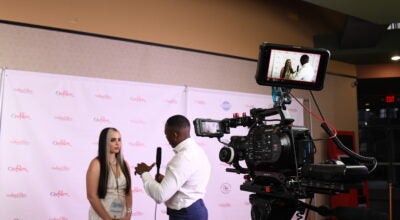
More than 1K people attended 2024 Oxford Film Fest
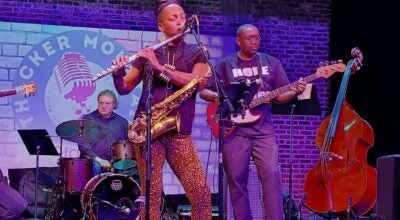
Photos: Thacker Rocks!
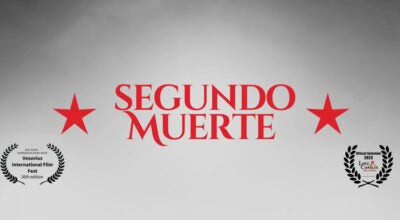
‘Segundo Muerte’: A love letter to Latin culture

Church Directory, Oxford and Lafayette County
Friends2follow, special sections.
What is your opinion of Day Light Saving Time
- Wish it was all year long
- Wish we had standard time all year long
View Results
- Local Sponsored
- Classifieds
- Small Business
- Submit a News Tip
- Submit a Photo
- Sign Up for Our E-Newsletter
- © 2024, The Oxford Eagle

IMAGES
VIDEO
COMMENTS
The works are modeled after modern and historical vessels: container and battle ships, yachts, dinghies, cruise ships, rowboats, and houseboats. For example, with its wooden hull and tall masts rigged with capacious sails and lengths of rope, The Wine Dark Sea, BB (2016) recalls the ships of pirates, explorers, or colonialists. The powerful ...
Cruise ships, gold-filigreed galleons, a Coast Guard boat, a dugout canoe, and sailboats all careen together in suspended motion, in an installation consecrated to refugees from Syria and Iraq. Locke christened it "The Wine Dark Sea" in homage to Homer's "Odyssey" but also to Derek Walcott's epic poem "Omeros," which recasts the ...
The Wine Dark Sea, U references a Coast Guard skiff. The Wine Dark Sea, AA, takes its inspiration from a more pedestrian sailing boat. The Wine Dark Sea, CC alludes to a stock military boat. The Wine Dark Sea, DD is a model of Sir Francis Drake's The Revenge, a flagship pitted against the Spanish Armada. (This sculpture evokes more generally ...
Sydney to Southport Solo. This year the delivery of Wine-dark Sea to Queensland for Airlie beach race week and magnetic island race week is being juggled with the final commissioning of the new Sydney football stadium. Eyeing up a potential 5 day weekend without commissioning and a favourable weather window, on the tail of a southerly blast, I ...
The Wine-Dark Sea is the sixteenth historical novel in the Aubrey-Maturin series by British author Patrick O'Brian, first published in 1993.The story is set during the Napoleonic Wars and the War of 1812.. This novel constitutes the fourth of a five-novel circumnavigation of the globe; other novels in this voyage include The Thirteen Gun Salute, The Nutmeg of Consolation, Clarissa Oakes/The ...
No crew are visible—the boats themselves stand for crew and passengers. "The Wine Dark Sea" is a selection of up to thirty-four boats, either hanging or on strands, ranging from 23 to 183 cms in length. Hew Locke was born in Edinburgh, UK, in 1959; lived from 1966 to 1980 in Georgetown, Guyana; and is currently based in London. He ...
Homer's "wine-dark sea" has puzzled scholars for centuries, leading ...
'The wine dark sea' is a description of the Mediterranean used by Homer throughout The Odyssey, and the phrase is repeated by Derek Walcott in his epic poem Omeros set mainly in the Caribbean, and referencing characters from The Iliad. ... Image above - The Wine Dark Sea, (boat BB), 2016, mixed media with custom hand embroidery, 76 x 33 x ...
Hew Locke The Wine Dark Sea, Group 1, 2016 Mixed Media Boat FF: 7 5/8 by 21 5/8 by 8 1/4 inches (19.5 x 55 x 21 cm) Boat Z: 14 3/4 by 48 7/8 by 10 1/8 inches (37.5 x 124 x 25.5 cm)
Wine-Dark Sea features immersive original and adapted stories from ancient history and mythology, based on authentic sources from Greece, Rome, and beyond. The channel aims to bring classical myth ...
Excerpts featured in this segment are Wine-Dark Sea (Mackey) performed by the University of Texas Wind Ensemble with conductor Jerry Junkin (Reference Recordings 137), Symphony No. 3 (Mahler ...
Sailing the wine-dark seas. Published 6:59 pm Tuesday, August 29, 2023. By Staff reports. By John Nelson. Columnist. The U.S. Merchant Marine Academy's class of 1965 holds reunions every five years, and lately, we've started having mini-reunions in between. This year, about 20 gathered in Memphis for a cruise up the Mississippi.
The Wine-Dark Sea: The Americans By Mike Bennighof, Ph.D. October 2019. When you stare at a game design long enough, you end up wanting to make changes. Some of those actually improve the game; most of those impulses are best left unheeded. ... with only 22 3-inch guns to defend against torpedo-boat attacks.
The Wine-Dark Sea. by Vincent Edward Gadrix. View More. Read an excerpt of this book! Add to Wishlist. Shop Indie eBooks. The Wine-Dark Sea ... In a world of priceless art, opulent yachts, and oceanic galas, Amanda Edge is more than just an art dealer—she's an art detective. When a Gustav Klimt masterpiece vanishes, she embarks on a perilous ...
Wine-growers, Oenologists, Wine-makers, Sommeliers, University Professors, Chefs, wine critics and Masters of Wine, guide us in a journey through time, following the paths of Homer to discover "the island called Crete, in the midst of the wine dark sea" The viewer travels through the vineyards found in the valleys and the mountains of Crete ...
Wine-dark sea is a traditional English translation of oînops póntos ( οἶνοψ πόντος, IPA: /ôi̯.nops pón.tos/), from oînos ( οἶνος, "wine") + óps ( ὄψ, "eye; face"), a Homeric epithet. A literal translation is "wine-face sea" (wine-faced, wine-eyed). It is attested five times in the Iliad and twelve times in the ...
Books. The Wine-dark Sea. Patrick O'Brian. W. W. Norton & Company, 1993 - Fiction - 261 pages. At the outset of this adventure filled with disaster and delight, Jack Aubrey and Stephen Maturin pursue a heavy American privateer through the Great South Sea. The strange color of the ocean water reminds Stephen of Homer's famous description, but it ...
A3: Uhh, well I guess at midnight its black. But no, Homer's 'Wine-Dark' Sea is the Blue Sea. Oinops means blue. A4: Because scholars have interpreted Homer's Oinopa Ponton as the 'wine ...
Sailing the wine-dark seas. Published 8:30 am Wednesday, August 30, 2023 ... the hotel before they boarded the boat the next day, we had a chance to visit. ... reprieve from events unfolding to ...
The poet Homer called it "the wine-dark sea." While a two-week cruise is as superficial as a ship that skims the surface of the ancient Mediterranean, it's an honor just to share these places and try to listen to the stories each whispers. I hope that this "travel log" will allow us to share a bit of the color and adventure we shall experience.
He builds dread by the steady accrual of realistic detail, until the reader realises that the protagonist is heading towards their doom as if in a dream. First published in 1988, The Wine-Dark Sea contains eight stories that build towards disturbing yet enigmatic endings, including the classic story 'Your Tiny Hand is Frozen.' 'Of all the ...
Death in a Wine Dark Sea is pleasingly dark but filled with light, intriguingly unconventional while still being a satisfying. It's a red-herring filled mystery, a sensuous feast for all the senses, and a fantastic introduction to a modern-world, thoroughly American, high-society and intrepid Miss Marple for the 2000s.